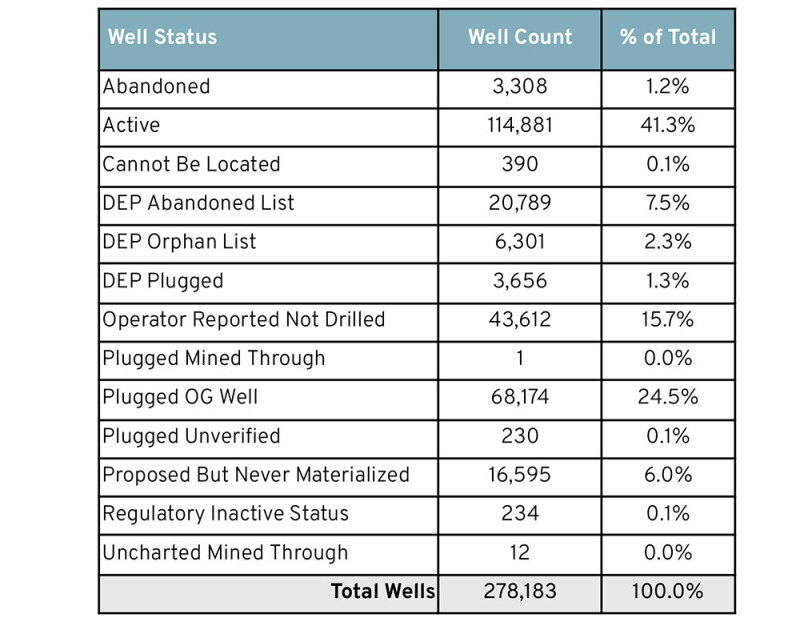Pennsylvania’s orphan well problem can be solved by better inventory management, clear definitions for well statuses, and the implementation of a severance tax or production fee, along with creation of site-specific trust accounts for all new wells permitted and drilled, according to a new report issued this month by the Ohio River Valley Institute. The state’s long history of oil and gas drilling operations has made it ground zero for the orphaned well issue in the US.
Pennsylvania is the nation's second-largest natural gas producer after Texas, with natural gas marketed production in the state totaling almost 7.6 Tcf in 2023, according to the US Energy Information Administration.
Drilling in the state dates to the 1850s, and the Pennsylvania Department of Environmental Protection (PADEP) currently lists 30,000 unplugged abandoned and orphaned wells that do not have assignable operators. Those will require public funding to properly decommission.
That number is expected to grow as new beds of orphan wells are discovered. PADEP has records for around 218,000 drilled wells in the state but estimates that as many as 560,000 wells are unaccounted for in state records, according to the report authored by Ted Boettner and Aimee Mantell.
Coauthor Mantell called plugging a well in Pennsylvania today “de facto voluntary,” adding that low bonding amounts and a regulatory authority inhibited by a “culture of non-compliance” have had little effect on inducing plugging and abandonment work across the state.

To further the hunt for rogue wells, The Oil Region Alliance, along with partners the Environmental Defense Fund, PennState Extension and the PADEP, has launched a $100 bounty program for the location of previously unknown abandoned oil and gas wells across the state. The partnership plans workshops throughout July to teach individuals how to identify and report orphan wells. Once a new orphan is discovered, its location will be compared to an existing abandoned well database to determine if it is indeed new. Ultimately, PADEP will visit the site to determine the condition of the well and if it needs to be plugged immediately due to the risk posed to the environment.
Even if new wells are discovered and have assignable operators, that is no guarantee of timely abandonment. The Ohio River Valley Institute report found that most wells that received a violation notice for nonabandonment from 2014 to 2023 have still not been plugged. Only 419 of the 3,293 were ultimately plugged, while 466 produced oil or gas in 2024, according to the report.
The report also found a culture of noncompliance within the PADEP with regards to mandatory reporting requirements. Once a well in the state has not produced oil or gas in the prior 12 months, it is required to be plugged by law, unless it has been granted regulatory inactive status. However, between 2017 and 2021, the report states that nearly 55% of conventional well operators (with at least 11 wells) did not submit required reports. Over 3,100 violations for failure to plug an abandoned well were issued over that same period, just over 40% of total violations.
During testimony given to the Pennsylvania House Environmental & Natural Resource Protection Committee on 12 June, coauthor Boettner said today the onus to prove a well is abandoned falls on the PADEP and not the operator.
“It should be the opposite,” he said. “PADEP should issue administrative plugging orders to operators that routinely fail to submit a production report, repurpose their well, or put the well in regulatory active status. Notices of violations for failure to plug should be issued not just during onsite inspections, but administratively. This would expedite enforcement. The PADEP should also use its power to deny permits to operators with wells that are not in compliance.”
Solutions offered by the report include adoption of a minimum production threshold to ensure wells producing at uneconomic rates or not producing at all be decommissioned. The authors believe the threshold would assist in determining wells that are at high risk of becoming orphaned.
Enacting a severance tax or production fee would be expected to improve compliance with proper reporting in addition to bringing funds into the state for decommissioning wells. According to the report, Pennsylvania is the only large oil and gas-producing state that does not have a severance tax. Ohio collected $58 million in oil and gas severance taxes in 2024, with 90% going to help fund plugging orphaned wells.
The report also pitches requirements for new wells to have site-specific trust accounts that include a surety bond as a financial backstop, firm deadlines for the plugging of inactive wells, and an upgraded well management system including integration of a risk data management system, and more robust enforcement within the already-established state laws.
Read the full report here.


